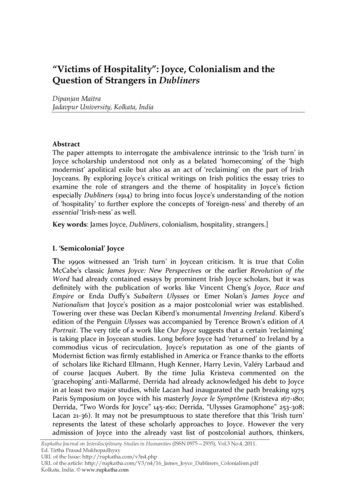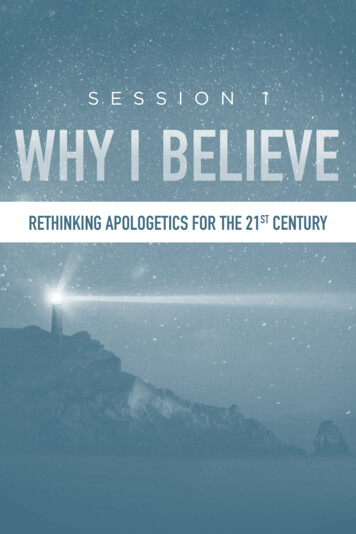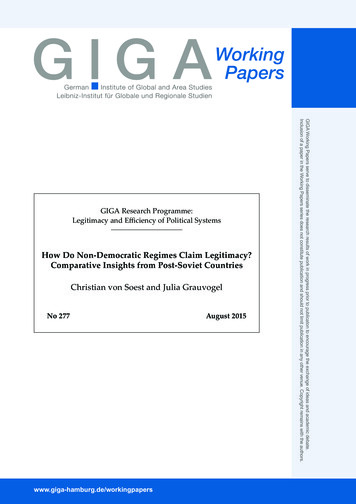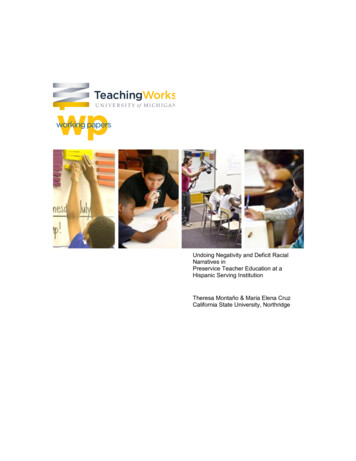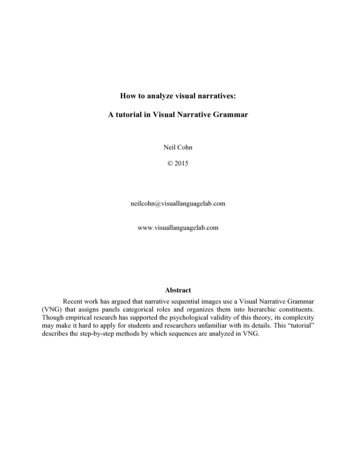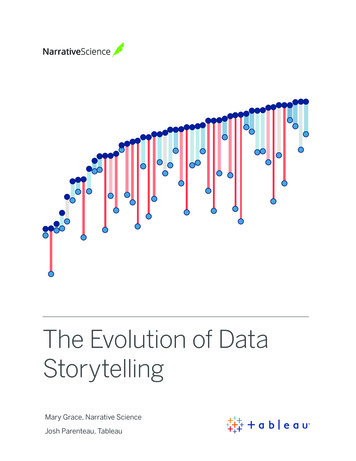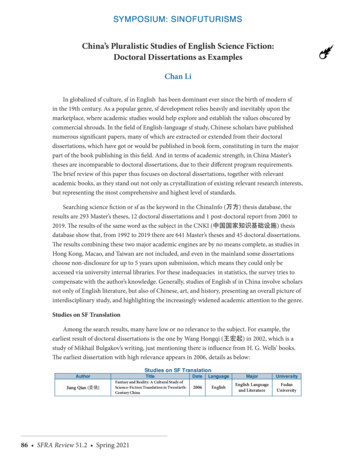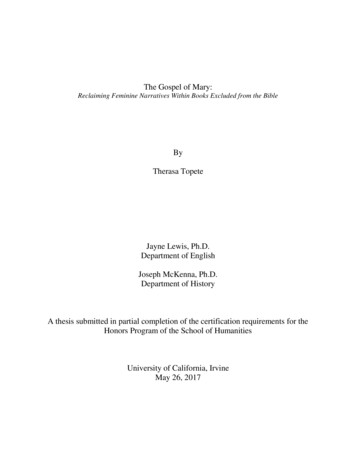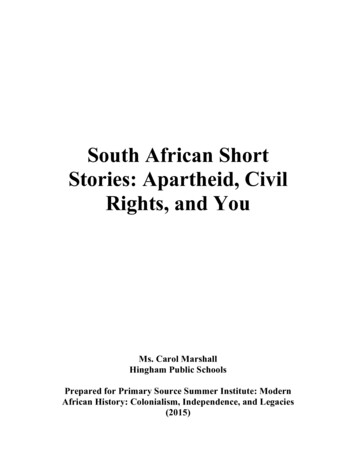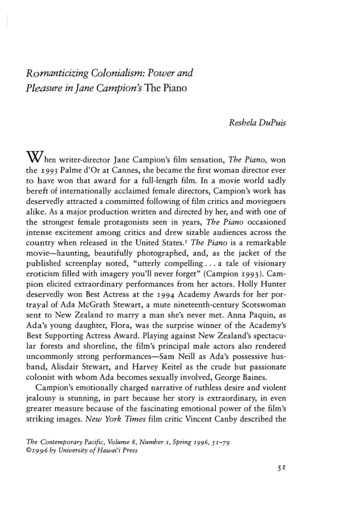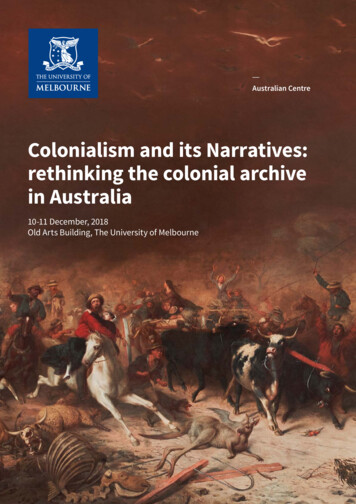
Transcription
Australian CentreColonialism and its Narratives:rethinking the colonial archivein Australia10-11 December, 2018Old Arts Building, The University of MelbourneThe University of Melbourne1
CONFERENCEPROGRAMMonday 10 December8.30 – 9.10amRegistrationEast foyer, Ground Floor, Old Arts9.10 – 9.30amWelcome to Country/Convenor’s welcomeTheatre D, Room 155, Ground Floor, Old Arts9.30 – 10.30amKeynote 1Colonial Narratives: Affect and archival subjectsLynette Russell, Monash UniversityChair: Ken GelderTheatre D, Room 155, Ground Floor, Old Arts10.30 – 11.00amMorning TeaArts Hall, Room 222, Level 1, Old Arts11.00am – 12.30pmPanels 1, 2 and 3Panel 1: Colonial Art and Representation.Theatre A, Room 103, Ground Floor, Old ArtsChair: Alison InglisViolence in the Drawing Room: Frontier Imagery in the Colonial AlbumMolly Duggins, National Art SchoolCountering Colonial Vision: William Barak’s paintingsNikita Vanderbyl, La Trobe UniversityPeripheral Vision: recurring colonial imagery of Aboriginal Australians as framing devicesLiz Conor, La Trobe UniversityPanel 2: Women, Agency, and Colonial Administration.Theatre B, Room 129, Ground Floor, Old ArtsChair: Jodie BoydSecuring a Protector vs. an Expression of Independence: marriage options for immigrant women in colonialAustraliaLiz Rushen, Monash University,Convicts and their Families as Colonial SettlersPerry McIntyre, Anchor Books Australia‘Properly and Safely Delivered’: maternity attendance by women in Victoria 1851-1881Madonna Grehan, University of Melbourne2Colonialism and its Narratives: rethinking the colonial archive in Australia
Panel 3: Convicts, Soldiers, and BushrangersMacmahon Ball Theatre, Room 107, Ground Floor, Old ArtsChair: Paige GleesonOn the Run: Pursuing Robert Knox through the convict archiveJennifer Bird, Australian National University‘Those Other Exiles’: A soldier’s Life on the Penal Frontier of New South Wales 1804-1842Tamsin O’Connor, University of SydneyThomas Bock’s Sketches of Bushrangers: Brutality behind BeautyRachel Franks and Richard Neville, State Library of NSW12.30 – 1.30pmLunchArts Hall (222), Level 1, Old Arts1.30 – 3.00pmPanels 4, 5 and 6Panel 4: Colonial Policy, Governance and the LawTheatre A, Room 103, Ground Floor, Old ArtsChair: Anna Johnston‘Contrary to the spirit of the age’: Imprisonment for Debt in Colonial Victoria, 1857-1890Jodie Boyd, RMIT University and University of Melbourne(This paper was co-authored with Ian Ramsey and Paul Ali, Melbourne Law School, University ofMelbourne.)Commissioning Evidence: Deconstructing the Bigge ArchiveMatthew Allen, University of New EnglandRiding the Tide of Change: negotiating archival principles while being mindful of the colonial gazeBethany Sinclair-Giardini, Shire of Yarra Ranges CouncilPanel 5: Colonialism, Museums, ExhibitionsTheatre B, Room 129, Ground Floor, Old ArtsChair: Molly DugginsColonial art exhibitions: curating beyond bordersAlison Inglis, University of MelbourneAssembling Victorian Aboriginal Collections and Understanding Global Networks of Museum ExchangeJocelyn Bardot, University of MelbourneOceanic Photography: Uncovering histories of collection and cultural production in the Antipodean museumPaige Gleeson, University of TasmaniaPanel 6: Publishing, Books, NetworksMacmahon Ball Theatre, Room 107, Ground Floor, Old ArtsChair: Jessica WhiteParallel Import Restrictions: colonial legacy and national cultureSarah Ailwood and Maree Sainsbury, University of CanberraLa Vie de Boheme in Colonial MelbourneKen Stewart, Western Sydney UniversityE.W. Cole: cosmopolitan reasoner in the global southTanja Luckins, La Trobe UniversityThe University of Melbourne3
3.00 – 3.30pmAfternoon TeaArts Hall (222), Level 1, Old Arts3.30 – 5.00pmPanels 7, 8 and 9Panel 7: Collecting KnowledgeTheatre A, Room 103, Ground Floor, Old ArtsChair: Rachael Weaver‘That’s White Fellow’s Talk You Know, Missis’: wordlists, songs, and knowledge production on the colonial frontierAnna Johnston, University of QueenslandF. P. Dodd (1861-1937), eco-pedagogue and natural historian of Far North QueenslandDeirdre Coleman, University of Melbourne‘The Most Formidable Teeth’: gardening and collecting in 19th century south-west Western AustraliaJessica White, University of QueenslandPanel 8: Farmers and PastoralistsTheatre B, Room 129, Ground Floor, Old ArtsChair: Ken GelderThe Settler Colonial Farm Novel in AustraliaTony Hughes-d’Aeth, University of Western AustraliaStories that Disrupt the Prevalent Settler Colonial Historical EpistemologySkye Krichauff, University of AdelaideThe narrative of the Independent Yeoman in 1860s Victoria and its DiscontentsWill Peart, Deakin University, MelbournePanel 9: Colonialism and Contemporary AustraliaMacmahon Ball Theatre, Room 107, Ground Floor, Old ArtsChair: Liz ConorCountering the Colonial Archive: language and place-based storytelling in Kim Scott’s fictionDorothee Klein, University of StuttgartFamily HistoriographiesJoseph Cummins, ResearcherAfter the Crow Flies: collaboration, colonialism, the archive, and artist’s filmSonal Kantaria, King’s College London (withdrawn)5.00 – 6.00pmKeynote 2Black Line/Confiscation Line: Risky Performances and Contesting Reconciliation in Australia andAotearoa New ZealandPenny Edmonds, University of TasmaniaChair: Lynette RussellTheatre D, Room 155, Ground Floor, Old Arts4Colonialism and its Narratives: rethinking the colonial archive in Australia
Tuesday 11 December9.30 – 10.30amKeynote 3Dark EmuBruce Pascoe, Wathaurong Aboriginal Co-operativeChair: Greg LehmanTheatre D, Room 155, Ground Floor, Old Arts10.30 – 11.00amMorning TeaArts Hall, Room 222, Level 1, Old Arts11.00am – 12.30pmPanels 10, 11 and 12Panel 10: Colonial PoetryTheatre A, Room 103, Ground Floor, Old ArtsChair: Deirdre ColemanAustralia 1819: European Inscription in the South PacificJustin Clemens and Tom Ford, University of MelbourneA Poem and its Narratives: Henry Lawson’s ‘The Shanty on the Rise’Michael Farrell, Poet‘Bunyip Aristocracy’ and the Foundation of Australian PoetryMatthew Hall, Deakin UniversityPanel 11: Colonisation and Indigeneity 1Theatre B, Room 129, Ground Floor, Old ArtsChair: Alison Inglis(Dis)regarding the savages: terra nullius in Tasmanian colonial artGreg Lehman, University of MelbourneUnsettling the Colonial Narrative: archival records in Aboriginal family storiesTonia Chalk, University of Southern QueenslandPanel 12: Colonialism, Museums, CollectionsMacmahon Ball Theatre, Room 107, Ground Floor, Old ArtsChair: Rachael WeaverColonialism and Genocide in the MuseumBeatrice Harris, Deakin University‘A Typical Aboriginal Scene’: Colonial Museums as Archives, c.1862-1917Gemmia Burden, University of QueenslandScratching the Surface: Colonial Places & Faces in ‘Paintings from the Collections’ at the State LibraryMargot Riley, State Library of NSW12.30 – 1.30pmLunchArts Hall, Room 222, Level 1, Old ArtsThe University of Melbourne5
1.30 – 3.00pmPanels 13, 14, and 15Panel 13: Colonial Buildings and ArchitectureTheatre A, Room 103, Ground Floor, Old ArtsChair: Gemmia BurdenThe architecture of resource extraction, labour, travel and trade: the Burns Philp empire andinter-colonial modernityAmanda Achmadi, Paul Walker and Karen Burns, University of MelbourneTransposing Mediaeval Gothic to Colonial Australia: the case of St Patrick’s cathedral, MelbournePaola Colleoni, University of MelbourneTrans-colonial family enterprises at the frontier: the forgotten origins of Australian colonial architectureHarriet Edquist, RMIT University and Stuart King, University of MelbournePanel 14: Colonial Women, Institutions, AspirationsTheatre B, Room 129, Ground Floor, Old ArtsChair: Beatrice HarrisUnruly Women: mechanical restraint on the female patients in the Fremantle Lunatic Asylum 1858-1908Alexandra Wallis, University of Notre Dame‘I Do Trust the Little Money You Had is Safe’: women, faith and financial risk from the perspective ofthe Bendigo goldfieldsJennifer Jones, La Trobe UniversityPanel 15: Colonialism and Indigeneity 2Macmahon Ball Theatre, Room 107, Ground Floor, Old ArtsChair: Tonia ChalkHow the Jancourt resisted colonisationAlycia Nevalainen, Australian National UniversityUncomfortable Heritage and Makarrata: listening to truth about the Aboriginal fringe camps ofSouth West QueenslandJane Palmer, University of Southern QueenslandIndigenous artefacts as items of trade, performance and art in Colonial VictoriaKathryn Wells, Australian National University3.00 – 3.30pmAfternoon TeaArts Hall, Room 222, Level 1, Old Arts3.30 – 5.00pmPanels 16, 17, 18 and 19Panel 16: Colonial Policy, Governance, InfluenceTheatre A, Room 103, Ground Floor, Old ArtsChair: Harriet EdquistImperial Perspectives on Colonial Australia: British views of Indigenous protectionZoë Laidlaw, University of Melbourne‘Good Manners are not Among the Products of the Antipodes’: colonial Australia, imperial foreign policy, andthe problems of Greater BritainBenjamin Mountford, Australian Catholic UniversityProvenance and the Archbishop’s LibraryHuw Sandaver, Mannix Library, Melbourne6Colonialism and its Narratives: rethinking the colonial archive in Australia
Panel 17: Colonial SpeciesTheatre B, Room 129, Ground Floor, Old ArtsChair: Rachel FranksIndigenous and Settler Relations in the Colonial Kangaroo HuntKen Gelder and Rachael Weaver, University of MelbourneA Jackass for One Nation: The introduction of the Laughing Kookaburra into Tasmania and WA as anationalistic gestureFernando do Campo, University of New South WalesPanel 18: Settler RelationsMacmahon Ball Theatre, Room 107, Old ArtsChair: Margot RileyHalf-Started BridgeBonny Cassidy, RMIT UniversityIndigenous Australians in the Italian imaginaryRobert Pascoe, Victoria University; and Gerardo Papalia, La Trobe UniversityArchival futures: remembering colonial narratives across cultural differencesOlivia Guntarik, RMIT UniversityPanel 19: Settler Colonialism, Theory, NationTheatre D, Room 155, Ground Floor, Old ArtsChair: Kathryn WellsEgalitarian Nationalism: Justifying Australian nationhood without justifying colonisationBenjamin Jones, Australian National UniversityLabouring the Subject: imperial work in Australia’s colonial environmentDaniel Hempel, University of New South Wales (withdrawn)A Poetics of Colonial Irony: Paul Carter and the writing of settler self-undoingScott Robinson, Monash University5.00 – 6.00pmKeynote 4Curating the Colonial: Reflections on ‘The National Picture: The Art of Tasmania’s Black War’Tim Bonyhady, Australian National University and Greg Lehman, University of MelbourneChair: Ken GelderTheatre D, Room 155, Ground Floor, Old Arts6.00pmClose and Thanks6.30pmConference DinnerNaughtons Parkville Hotel, 43 Royal Parade, Parkville(pre-booked places only)The University of Melbourne7
ABSTRACTSKeynote 1Lynette Russell (Monash University, Melbourne), Colonial Narratives: Affect and archival subjectsChair: Ken GelderIt is a common understanding that Australia was colonized without the consent of the traditional owners despite substantial andunequivocal instructions from the British Colonial Office. Nearly thirty years ago Henrietta Fourmile described Aboriginal people as‘captives of the archives’ and alerted us that engaging with historical materials which emerge out of this illegal occupation can implicatethe researcher in the ongoing processes of colonialism. Historians, and other users of archives, often observe the excitement and emotionof their ‘discoveries’. Archives containing the physical remains of the past can transport us, we can move beyond the here and now wecan time travel and retrace the past. For many Aboriginal people archival research can also be a minefield of affect and distress. In thistalk I will consider several case studies where the experience of delving into colonial archives elicits complex responses ranging fromre-inscribing historical trauma, to the euphoria of discovering lost ancestors and kin. The colonial archives and the narratives they enableus to develop are forever enmeshed in delicate tension as the researcher attempts to balance the power of the written word with the livedexperience of the archival subjects.Keynote 2Penny Edmonds (University of Tasmania), Black Line/Confiscation Line: Risky Performances and Contesting Reconciliation inAustralia and Aotearoa New ZealandChair: Lynette RussellPhilosopher and playwright Hélène Cixious has described theatre as ‘by definition the stage where the living meet and confront the dead,the forgotten and the forgettors, the buried and the ghosts, the present, the passing, the present past and the passed past’. Nowhere, Iargue, is this more apparent than in the working through of the public, performative politics of reconciliation in settler societies, whereIndigenous and non-Indigenous peoples meet in the long shadow of colonial frontier violence. In this talk, I explore two Indigenous-ledperformances that deal directly with the colonial past and its aftermath: Tame Iti’s fiery re-enactment of the New Zealand Land warsat the historic confiscation line in Ngāi Tūhoe country in 2005, and the ‘Black Line’ ceremony in Tasmania in 2001. This talk considersthese material lines of colonial warfare in the landscape and the ‘lines’ of the settler archive that serve to entrench colonial narrativesagainst the re-visioning ‘lines’ of subversive Indigenous performance. Rather than peace-building ceremonies of unity and good feelingaccompanied by the handshake that are the signature gesture of state based reconciliation, this talk explores the radical crossings of twocolonial lines of violence and the ‘affective alchemy’ of the performances, including anger/rejection, endurance/survival and togethernessas performed by Indigenous peoples and others as they make claims on the settler state. These are risky performances, fierce acts of antiforgetting drawn from the archive of Indigenous embodied genealogy and action, which reject colonial narratives and refuse that thesesites of violence remain as ‘dumb places’ where the events of the past cannot be spoken.Keynote 3Bruce Pascoe (Wathaurong Aboriginal Cooperative), Dark EmuChair: Greg LehmanMyths about the lives of pre-colonial Aboriginal and Torres Strait Islander people have proven deeply entrenched. But in his 2014 bookDark Emu, Bruce Pascoe struck a grievous blow to one of the most widely accepted assumptions of Australian pre-settlement history. Heargued, and presented robust evidence drawn from the journals of European explorers, that Indigenous people were not hunter-gatherersat the time of colonisation.‘The evidence insists that Aboriginal people right across the continent were using domesticated plants, sowing, harvesting, irrigating andstoring – behaviours inconsistent with the hunter-gatherer tag,’ he has said.8Colonialism and its Narratives: rethinking the colonial archive in Australia
Dark Emu, which won Book of the Year at the 2016 NSW Premier’s Literary Awards, also challenges existing narratives around housingconstruction, cooking and clothing prior to European settlement. What does challenging the past of Aboriginal and Torres Strait Islanderpeople mean for the present?Keynote 4Tim Bonyhady (Australian National University) and Greg Lehman (University of Melbourne), Curating the Colonial: Reflections on‘The National Picture: The Art of Tasmania’s Black War’Chair: Ken GelderTim will discuss how the exhibition evolved as a jointly curated venture; Greg will discuss the Aboriginal community consultation process,including the responses to the Robinson material; Tim will discuss the proposed exclusion of the Law bust of Robinson at the TMAGshowing of the exhibition; Greg will discuss the exclusion of the French lithographs at TMAG and their inclusion at QVMAG; Tim will discussthe omission of Duterrau’s Conciliation from QVMAG and how one of David Gough’s spears came to be the front-of-house work; and Gregwill conclude with some reflections on the show.Panel 1: Colonial Art and RepresentationChair: Alison InglisMolly Duggins (National Art School, Sydney), Violence in the Drawing Room: Frontier Imagery in the Colonial AlbumFocusing on an album compiled by Eliza Younghusband in Adelaide between 1856 and 1865 (NLA), this paper considers how images ofcolonial settlement were domesticated through album assemblage. Typical of women’s albums from the mid-nineteenth century, whichhighlighted the accomplishments and connections of the compiler, Younghusband’s album presents a topography of taste and sentimentin its assembled picturesque views of European and Australian scenery, flower paintings, embossed scraps and poetry intended fordisplay in the drawing room. However, interspersed amongst its pages are images of an inhospitable Australian landscape distinguishedby frontier conflict, notably a number of drawings by William Oswald Hodgkinson relating to the Victorian Exploring Expedition of 1860-61.While such images provide critical visual evidence of the legacy of violence associated with colonial settlement, their original receptionremains understudied. I propose that the documentary value of Hodgkinson’s drawings was subsumed in the sentimental framework ofYounghusband’s album and its malleable social, memorial and artistic narratives. The drawings acquired new significance as mementosof the relationship between Younghusband and Hodgkinson, while their arrangement in the album and its display in the drawing room, asymbolic bastion of colonial domesticity, served to enshrine the expedition imagery within an aesthetic re-envisioning of the Australianlandscape.Nikita Vanderbyl (La Trobe University, Melbourne), Countering Colonial Vision: William Barak’s paintingsColonial narratives were formed through concomitant ways of seeing, often referred to as the colonial gaze, denoting a preferential orpartial vision. Missionaries, as one example, did not perceive and actively prevented the expression of Indigenous spiritual beliefs. Thiscontributed to a deficit model of Aboriginal and Torres Strait Islander cultures. Such a narrative contributes to what W.E.H. Stannertermed the Great Australian Silence, and this narrative of deficiency has done pervasive damage to Indigenous peoples. Counteringsuch ways of seeing are examples of Aboriginal art from the colonial period. This paper takes the paintings of Wurundjeri artist anddiplomat William Barak (c.1824-1903) as its example. His vibrant depictions of ceremonies and events recalled in later life present acounter narrative. This paper will contextualise his work through the collecting practices of Friedrich August Hagenauer, missionary andproponent of this colonial vision in Victoria. Hagenauer is less well-known as a collector of natural history and Aboriginal belongings(material culture and art), including three of Barak’s paintings which he donated to the Herrnhut Museum of Ethnography in Germany. Thispaper has a dual focus on Aboriginal resistance in visual art and the construction of colonial narratives about Indigenous peoples.Liz Conor (La Trobe University), Peripheral Vision: recurring colonial imagery of Aboriginal Australians as framing devicesIn many colonial prints - engravings, etchings, lithographs, etc - of Aboriginal Australians they appear as human annotations on the peripheryof topographic landscapes or nascent cities. While art conventions of the era commonly used peasants, strollers, shepherds and other figuresto establish human scale this paper will argue that in colonial prints this convention was put to another purpose, that of representing themarginal status of the original custodians of the land on which they appear - both as tenuous nomadic custodians, and as anomalous to,displaced and sidelined by the scenes of colonial modernity they appear to footnote. The paper will survey changes to this convention tobetter understand how people, both Aboriginal and Settler, were ‘put in the picture’ of these printed ‘prospects for settlement’.Panel 2: Women, Agency, and Colonial AdministrationChair: Jodie BoydLiz Rushen (Monash University, Melbourne), Securing a Protector vs. an Expression of Independence: marriage options forimmigrant women in colonial AustraliaIn the 1830s, the Australian colonies were presented in the promotional literature as places of enhanced employment possibilities andviable marriage opportunities. In her 1836 application to the governor of New South Wales to marry the convict Edward Waller, newly-The University of Melbourne9
arrived Irish immigrant Margaret Mahoney stated that her aim was ‘to secure a protector, as well as to obtain a future maintenance fromhis industry’. What had driven this free immigrant woman to bind herself in marriage to a convict man within a year of her arrival in thecolony?A recurring theme in the lives of colonial immigrant women was their propensity to marry the convict of their choice. Was romantic lovethe driving force, or something more tangible? When a female immigrant sought permission to marry a convict, she tended, like MargaretMahoney, to emphasize the usefulness of his skills, the personal qualities of her intended partner and his ability to provide ‘protection’for her. Yet there were many free settlers able to provide these attributes with the added attraction of freedom from government controlover their lives. Drawing on colonial office archives and contemporary sources, this paper will offer new insights into the marriage optionsavailable to colonial immigrant women in the 1830s.Perry McIntyre (Anchor Books Australia), Convicts and their Families as Colonial SettlersBanishment from family was a principal punishment inflicted by transportation, and wives and children were left in Britain and Irelandwithout support when their male breadwinner was gaoled and removed to the colonies. However a group of women and children weregiven free passages to join their husbands and fathers in Australia, reversing what would have been permanent separation. The fateof some of these families and their contributions to colonial society is examined in this paper. Sources include convict and emigrationdocuments in archives in Australia, Britain and Ireland.Madonna Grehan (University of Melbourne), ‘Properly and Safely Delivered’: maternity attendance by women inVictoria 1851-1881At least until the 1890s in Australia, the vast majority of women had their babies at home, with around half attended by women. Just whowas at the maternity bedside, and on what basis, has been open to speculation because midwifery by women was unregulated in thenineteenth century, leaving few records as evidence of practice. Conventional history viewed women attendants harshly, aligning themwith Mrs Sarah Gamp, a grubby fictional character created by Charles Dickens in 1843 for his serialised novel The Life and Adventures ofMartin Chuzzlewit.Recent research, informed by an unlikely primary source, shows that a plurality of women provided maternity attendance in colonialAustralia, many successfully and most in stark contrast to the fictional stereotype of Mrs Gamp. Female attendants ranged fromprofessed midwives, nurses, monthly nurses, granny midwives, to family members and neighbours. As evidence of the field, I use coronialinvestigations into maternal deaths. These records inevitably illustrate the worst of all outcomes, but also offer unexpected and realisticinsights into women’s motivations and agency in taking up maternity practice.Panel 3: Convicts, Soldiers, and BushrangersChair: Paige GleesonJennifer Bird (Australian National University), On the Run: Pursuing Robert Knox through the convict archiveConducting appraisals of convicts transported to Australia is laborious. Shipping indents, convict records, police gazettes, gaol entranceand description books, newspaper articles, books and various other records must be examined. Through developments in informationtechnologies and the ongoing digitisation of historical records, more information and richer data are increasingly available to draw newand deeper understandings about the convict experience.While stories of the notorious and rehabilitated dominate the literature, little research has been conducted on recidivists. A study of asingle recidivist convict adds to the scholarship and brings a biographical case study to the historical debate. Moreover, microhistoricalmethods challenge how we think about convicts and the colonial penal system. This paper explains how I stumbled upon recidivistconvict Robert Knox and pursued him through the archives: from a night-time food raid in Mount Victoria to an uprising on Norfolk Island;and from being one of penal reformer Alexander Maconochie’s ‘best men’ to being one of the worst ‘old-lags’ in the colony. Using digitisedrecords, I have been able to uncover a story of twenty-nine years of incarceration over a span of forty years.Tamsin O’Connor (University of Sydney), ‘Those Other Exiles’: A soldier’s Life on the Penal Frontier ofNew South Wales 1804-1842This paper examines the military function of the penal station of Newcastle (1804-1821) through the story of two timber boxes. Thefirst, The Macquarie Chest, is among the most precious items in the collection of the Mitchell Library, while the second is but a roughcedar box constructed to contain a soldier’s necessaries - ‘a small thing Forgotten’. The history of the construction and contents of thesevery different artefacts has hitherto been told in a curatorial context but this paper aims to reveal a more complex militarised history ofexploitative power relations and colonial dispossession.Moreover, it emphasizes that the well-documented convict cargo was accompanied by a far more elusive group of involuntary arrivals– the soldiers. We know much about the regiments that served in New South Wales, but far less about the enlisted men who gave themform and force. This paper, while seeking to negotiate the micro-geographies of class, race, gender and power on the penal frontier, alsoaims to reveal that the soldiers were less tangential to the construction of convict society (as opposed to the destruction of indigenoussociety) than the monolithic archive of the Colonial Office would have us suppose.10 Colonialism and its Narratives: rethinking the colonial archive in Australia
Rachel Franks and Richard Neville (State Library of NSW, Sydney), Thomas Bock’s Sketches of Bushrangers: Brutality behind BeautyThomas Bock (1790-1855), was a talented portrait painter, engraver and photographer. Born in England, he was dispatched to VanDiemen’s Land (now Tasmania), Australia as a convict in 1824. Upon arrival in the penal colony, Bock was put to work as an artist for theadministrators and colonists of the settlement. Well-known for his images of Aboriginal Australians, Bock also produced extraordinarysketches of bushrangers. This paper explores an album of twenty-five drawings, including bushrangers and murderers (held at the StateLibrary of New South Wales), unpacking how brutal felons were re-imagined, by Bock, as beautiful subjects. These images, a set of pencilsketches, do not convey men as career criminals, but rather, gentlemen: respectable citizens in an outpost of the British Empire. In thisway, a convicted man has successfully challenged how we read and interpret images, of criminals, created in colonial Australia. Critically,these sketches disrupt traditional approaches to the construction of the evil Other and highlight the need for cultural institutions tocollect multiple truths. These informative and highly-stylised portraits encourage viewers to move beyond stereotypes of ‘bad men’ and‘good men’ and, by extension, invite us to reconsider the role of the image in colonial society.Panel 4: Colonial Policy, Governance and the LawChair: Anna JohnstonJodie Boyd (RMIT University, Melbourne), ‘Contrary to the spirit of the age’: Imprisonment for Debt in ColonialVictoria, 1857-1890The reintroduction in 1857 of imprisonment for debt in colonial Victoria flew in the face of international momentum for its abolition.In its criminalisation of debt and poverty, the Fellows Act (21 Vict 29) also defied the rapid advancement of democratic and egalitarianprinciples in the fledgling colony. Frequently referred to as ‘gross class legislation’, the law was used unabashedly to target poor smalldebtors, while leaving ‘mercantile men’ with significant debt untroubled by the prospect of a debtors’ gaol. This paper argues that the law,and its survival against the ‘spirit of the age’, can be understood as part of a broader story of conservative resistance to the democraticinnovations that threatened the power of the Victorian mercantilist establishment. It also offers an inquiry into the Fellows Act ascultural artefact; that is, law as an imaginative construction of a particular viewpoint and set of social, political, ideological and culturalunderstandings and beliefs. In this sense, the Act spoke both to the growing cleavages of social class and the grievances growing fromthe combined soils of nativist-nationalist-republican resentment against the recently landed sons of English gentry who sought to assertthemselves (and English practices) over the young Colony’s emerging institutions, society and politics.NB non-presenting co-authors:Ian Ramsay: Harold Ford Professor of Commercial Law and Director of the Centre for Corporate Law and Securities Regulation,Melbourne Law School, University of Melbourne;Paul Ali: Associate Professor, Melbourne Law School, University of Melbourne.Matthew Allen (University of New England), Commissioning Evidence: Deconstructing the Bigge ArchiveThe voluminous appendices and evidence presented by Commissioner Bigge to accompany his Reports on the Colony of New South Waleshave long shaped our understanding of the Macquarie era. The profusion of material Bigge gathered, ranging from letters to regulations,and lists to early statistical analyses was kept by the Home Office,
Justin Clemens and Tom Ford, University of Melbourne A Poem and its Narratives: Henry Lawson's 'The Shanty on the Rise' Michael Farrell, Poet . Benjamin Jones, Australian National University Labouring the Subject: imperial work in Australia's colonial environment Daniel Hempel, University of New South Wales (withdrawn)
